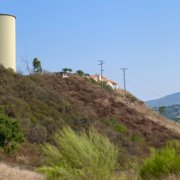New Reservoir to Protect Local Drinking Water Deliveries in North County
A major construction project to improve drinking water supply reliability in North San Diego County will start in February after the San Diego County Water Authority’s Board of Directors today approved an $11.4 million contract for the work to Pacific Hydrotech Corporation of Perris, Calif.
The Hauck Mesa Storage Reservoir project includes demolition of an abandoned steel tank, building a 2.1 million-gallon storage reservoir connected to the Valley Center Pipeline, and construction of an isolation vault and an underground flow control facility. The project is expected to be completed by winter 2022.
Infrastructure improvements ensure water delivery
Strategic infrastructure improvements by the Water Authority and its 24 member agencies are part of the regional effort to ensure continued delivery of water to support the region’s $245 billion economy and the quality of life for 3.3 million residents. The Water Authority just completed a $30 million series of upgrades on the historic First Aqueduct in North County to ensure these facilities continue to serve the region for many more decades.
“These upgrades are investments in our future,” said Water Authority Board Chair Gary Croucher. “Ever-changing conditions mean the work is complex and challenging, but continued vigilance helps ensure that we can meet our region’s water needs both today and for decades to come.”
As part of the asset management program, it is critical to actively replace and repair the Water Authority’s assets, which include pipes, valves, facilities, equipment and other infrastructure.
Operational flexibility
The new Hauck Mesa Storage Reservoir will provide operational flexibility, enhanced system reliability for the day-to-day operations of the aqueduct system, and help ensure water deliveries can be maintained even if power supplies are interrupted.
The Water Authority will continue to work closely with the Valley Center community, Valley Center Municipal Water District, and nearby homeowners to minimize short-term construction impacts.
For more information on the Hauck Mesa Storage Reservoir project, go to www.sdcwa.org/hauck-mesa-storage-reservoir.




